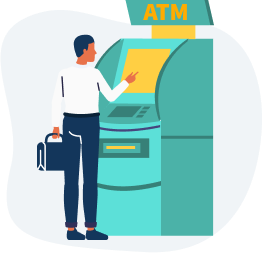Currency in Mexico
A Travel Money Guide to Mexico
Whether relaxing in a beachside resort in Cancun, admiring the archaeological sites of Teotihuacan or participating in the Day of the Dead festival, Mexico has a wide range of attractions for many tourists. Therefore it’s a good idea to learn everything you can about the local currency and payment options before you go.
The currency that is used in Mexico
In Mexico, locals use Mexican Peso to pay for things. It has the international code MXN, the symbol $ and is also the official currency in Mexico.
Money in Mexico
Mexican banknotes have 6 denominations: $20, $50, $100, $200, $500 and $1,000. Even though it was the first currency to use the $ sign it sometimes is presented as MX$, so it is not confused with US dollars.
The Mexican coin is called a ‘centavos’ and has 10 coin denominations: 5¢ 10¢, 20¢, and 50¢, as well as $1, $2, $5, $10, and $20.


Using Your Bank Card in Mexico
Most Mexican businesses are well set up to receive card payments. Some of the best travel money cards include debit, credit and prepaid cards. But before you use your bank card willy-nilly, it’s worth reading up on the fees and charges you might incur.
Debit Cards
You’ll probably want a debit card if you plan to withdraw money from an ATM. While you may also be able to pay with a debit card in some businesses in the major destinations, you might discover some hefty fees on your account summary.
Depending on your bank, you could be hit with fees for foreign ATM withdrawals or currency conversions. But some banks are better than others; we recommend checking out Wise, ING and Revolut, all of which have travel-friendly debit cards that waive these charges.


Credit Cards
Credit cards can come with some enticing perks, including added security, loyalty programs, and even free travel insurance.
But are they worth it?
Major local businesses, including hotels, restaurants, airline offices, and department stores, accept credit cards. But you might have to pay a surcharge.
Mastercard and Visa are widely accepted. You may also be able to use your American Express card, though local ATMs won’t accept them.
Just be aware of additional charges you may incur for foreign transactions. These could include:
- International transaction fees
- High exchange rate margins
- ATM fees
- Potential ‘cash advance fees’ if you use an ATM
If you still prefer credit cards over any other payment, consider going with a company that offers cards that waive certain travel fees. Bankwest Platinum and 28 Degrees both have travel-friendly cards.
Prepaid Travel Cards
The biggest advantages of prepaid travel cards are that you can lock in a favourable exchange rate. You also get a handy back-up card.
Just remember that while they are convenient, you could end up paying a long list of hidden fees. Many travel cards still impose:
- Currency conversion fees
- Uncompetitive exchange rates
- International ATM withdrawal fees
- Initial load fees
- Reload fees
- Inactivity fees

How to Buy Mexican Peso Before You Go
There’s a certain reassurance that comes with stepping off the plane (or cruise ship) already cashed up with Mexican Peso.
Buying Mexican Peso before you leave Australian shores isn’t just convenient. It can also save you money. But it all depends on where you get your Mexican Peso in Australia. There are three main options:
- Buy MXN online and have it delivered or collect it in-store
- Swap Australian dollars for Mexican currency from a money changer
- Buy your Mexican currency at your home airport
Currency exchange offices at Australian airports are notorious for their poor rates and commissions so we recommend avoiding that option entirely.
You’ll easily find a bureau de change near you; even suburban shopping centres should have at least one. But it’s better to get your money from an inner-city bureau if possible. They have more competition, which is likely to drive their rates down.
If there’s already too much running around to do ahead of your trip, consider ordering Mexican Peso online. You can choose to have them delivered or made available for pick-up at a location near you.
Online orders are often the best value too, especially if you go with S Money, which offers the same rates listed on Google and XE.com.
How Much Cash Should I Bring to Mexico?
Thanks to the surplus of ATMs and the ease of plastic payments, there’s not too much pressure on you to bring the exact amount of cash you need from the get-go.
Still, it’s a good idea to have a general daily budget to help you cost out the trip and make sure you don’t have leftover loonies at the end of your stay.
The average daily travel budget in Mexico is about $115. Some of the expenses you might be looking at include:

$90 per night
A double room in a hotel

$10
A meal at a restaurant

$1.50
A local beer

$1
A one-way public transport ticket

$22
Entrance ticket to a show or exhibit
How to Exchange Currency in Mexico
Places like Mexico City, and Cancun receive great numbers of tourists, so there are facilities to cater to money exchanges. Beyond these major destinations, it’s best to get cash before you venture into remote territory.

ATMs
ATMs are always open, reliable and available in most places in Mexico. Visa and Mastercard are commonly accepted as part of the Cirrus and Plus global networks.
Most Mexican banks charge a transaction fee to withdraw Mexico currency from a non Mexican account, so it better to take large sums out of ATMs than lots of little withdrawals.
Don’t forget: Let your bank know you’re travelling! If they detect a foreign transaction but aren’t aware you’re overseas, they could end up freezing your card.
Currency Exchange in Mexico
You won’t have any problem changing money in the city. There are plenty of money exchangers in Mexico City, Inter Foreign Exchange and Centro de Cambios are examples of 2 chains but most are stand alone businesses.
Money changers tend to offer marginally better rates than banks as many banks charge flat fees per transaction. Also, banks only exchange currencies on weekdays.


Travellers Cheques
Not worth the bother! Travellers cheques are so outdated, very few banks even accept them any more.
They can’t be used as direct payment, so the only way to use them once you’re in the country is to swap them for currency at a bank or a money exchange office. Even then, very few banks will accept travellers cheques if you don’t have an account with them. And exchange services apply exorbitant fees and rates to them.


